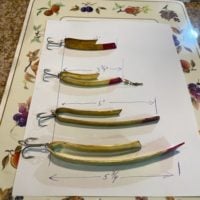I got tired of paying high prices for lures and decided to make my own super duper lures because they seem fairly effective and look easy to make. In addition to making several 1″ to 1-1/2″ super dupers, as you can see from the photo, I decided to try my luck at making large lures ranging from 3-1/4″ up to 5-3/4″. All were made from .064 x 1/2″ x 12″ brass stock that I bought at my local hardware store. However, the largest one is made from 3/4″ wide stock. And the smallest one is made from .032 thickness stock. The red paint is red fingernail polish from Dollar Tree.
The largest lure (from 3/4″ wide stock) failed to work. It rotates much too slowly. I’m unsure why. Maybe it has too much curvature, or too much mass, or maybe the treble hook is too large. Next time I’ll try it with less of a curvature and a smaller hook.
The next to largest lure worked wonders–I caught 4 trout with it in the first hour. Three trout were above 12″ long. One was only 8″. So he was barely longer than the lure!
The other two 3″+ lures also worked very well–I quickly caught two trout with each lure. However the lure made from thinner stock seems to rotate a little faster.
For the three lures that worked, they seemed to rotate fairly fast, and the tip of the rod would pulse at a rate of one pulse every one/half to one second. However, my rod would not pulse at all with the largest lure.
All the 1″ lures worked well and caught fish. Unfortunately, they were mostly smaller fish–less than 12″ long. So I’m inclined to keep using the larger lures.
I’m new at this, so I’m also wanting to know your insights for making large super duper lures. I’m sure that the lure action can be explained with better accuracy than my casual observations but I’m also not a mathematician or engineer. I expect that the metal thickness/weight, the diameter of the bend, and the ratio of the two legs of the lure affect how it acts, but I’m unsure how.
